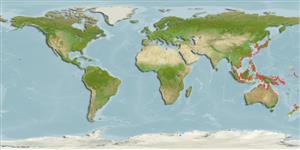Common names from other countries
Environment: milieu / climate zone / depth range / distribution range
Ekologi
; kisaran kedalaman 0 - 20 m (Ref. 348), usually 0 - 20 m (Ref. 75831). Tropical
Western Pacific: from the Malay Peninsula to the Philippines; north to Japan and south to northern New South Wales.
Length at first maturity / Size / Weight / umur
Maturity: Lm ? range ? - ? cm Max length : 7.5 cm SHL jantan/; (Ref. 348); common length : 6.0 cm SHL jantan/; (Ref. 348)
Collected locally for food in southeast Asian countries where the species is common (Ref. 348). Found in intertidal areas in sand (Ref. 75831). Occurs at low tide mark (Ref. 799).
Life cycle and mating behavior
Kematangan | Reproduksi, perkembang biakan | Pemijahan | telur-telur | Fecundity | Larva
Members of the class Bivalvia are mostly gonochoric, some are protandric hermaphrodites. Life cycle: Embryos develop into free-swimming trocophore larvae, succeeded by the bivalve veliger, resembling a miniature clam.
rujukan utama
Acuan | Koordinator | mitra
Poutiers, J.M. 1998. (Ref. 348)
Status IUCN Red List (Ref. 130435)
status CITES (Ref. 108899)
Not Evaluated
Not Evaluated
ancaman kepada manusia
Harmless
penggunaan manusia
| FishSource |
Alat, peralatan
informasi lanjut
Umur / Saiz
Pertumbuhan
panjang-berat
panjang-panjang
Morfologi
Larva
Kelimpahan
Sumber internet
Estimates based on models
Preferred temperature
(Ref.
115969): 18.8 - 29.1, mean 27.9 (based on 1066 cells).
keancaman
Low vulnerability (10 of 100).
kategori harga
Unknown.
